List of rulers of Croatia

.png)
History
The details of the arrival of the Croats are scarcely documented: c.626, Croats migrate from White Croatia (around what is now Galicia) at the invitation of Eastern Roman Emperor Heraclius. Between c. 641 and c. 689 Radoslav converts Croatia to Christianity.
Dukes of Croatia
| Portrait | Ruler | Began | Ended | Remarks |
|---|---|---|---|---|
| Porga or Porin | c. 660 | c. 680 | ||
| Višeslav (?) | 800 | 810 | ||
| | Borna | c. 810 | 821 | Vassal of Frankish Emperor Charlemagne; son of Višeslav |
| Vladislav | February 821 | c. 835 | son of Klonimir | |
| Mislav | c. 835 | c. 845 | ||
| Trpimir I | c. 845 | 864 | Founder of the Trpimirović dynasty | |
| Zdeslav | 864 | 864 | son of Trpimir I | |
 | Domagoj | 864 | 876 | overthrows Zdeslav |
| Iljko (?) | 876 | 878 | Iljko's name is disputed, an unnamed son of Domagoj succeeded to the throne, later killed during a civil war | |
| Zdeslav | 878 | May 879 | restored, overthrows unnamed son of Domagoj | |
| | Branimir | May 879 | c. 892 | killed Zdeslav in May 879 |
| Muncimir | 892 | 910 | son of Trpimir | |
| | Tomislav | 910 | 925 | |
Kings of Croatia
In his letter from 925, Pope John X refers to Tomislav as Rex Chroatorum - King of the Croatians. All Croatian rulers after Tomislav held the title of king.
House of Trpimirović
| Portrait | Ruler | Began | Ended | Remarks |
|---|---|---|---|---|
| | Tomislav | 925 | 928 | Probably son of Muncimir. After his death civil wars weakened the state and some territory, including Bosnia, was lost. His rank of "king" (rex) is based on two contemporary documents; a correspondence dated 925 where the Pope John X addresses him with that title and the transcript from the Synod conclusions in Split where he is also referred to as "rex". He was also addressed as "Princeps" ("Prince") and Duke (Dux) on other occasions. Nevertheless, in Croatia he is traditionally considered the first Croatian king. |
 | Trpimir II | 928 | 935 | Younger brother or son of Tomislav |
 | Krešimir I (Krešimir Stariji) | 935 | 945 | Son of Trpimir II |
 | Miroslav | 945 | 949 | Son of Krešimir I |
 | Michael Krešimir II (Mihovil Krešimir II) and Helen I (Jelena Zadarska) (co-rulers) | 949 | 969 | Younger brother of Miroslav. Michael Krešimir II ruled jointly with his wife Queen Helen I. Upon the King's death in 969 their son Stephen Držislav immediately took the throne alone, while the Queen Helen I died seven years later on 8 October 976. During their reign, the Croatian Kingdom regained previously lost territories, including Bosnia. |
 | Stephen Držislav (Stjepan Držislav) | 969 | 997 | Son of Michael Krešimir II. Queen Jelena of Zadar ruled as a regent for Stephen Držislav 969 - 8 November 975. He received royal insigia as an act of recognition from the Byzantine Emperor and was crowned by the Archbishop of Split in Biograd in 988. Thomas the Archdeacon's Historia Salonitana names him as the first King of Croatia (rex), regardless, he is considered the first crowned Croatian King.[1] |
 | Svetoslav Suronja | 997 | 1000 | Son of Stephen Držislav. Dethroned by his brothers Krešimir III and Gojslav |
 | Krešimir III and Gojslav (co-rulers) | 1000 | 1020 | Younger brothers of Svetoslav Suronja |
 | Krešimir III (alone) | 1020 | 1030 | Younger brother of Svetoslav Suronja |
 | Stephen I (Stjepan I) | 1030 | 1058 | Son of Krešimir III |
| | Peter Krešimir IV the Great (Petar Krešimir IV Veliki) | 1058 | 1074 | Son of Stephen I. During his reign the Croatian Kingdom reached its peak. |
 | Demetrius Zvonimir (Dmitar Zvonimir) | 1075 | 1089 | Cousin of Peter Krešimir IV. C. 1063 marries Princess Helen, daughter of King Bela I of Hungary. |
 | Stephen II (Stjepan II) | 1089 | December 1090 | Son of Častimir, who was younger brother of King Peter Krešimir IV. |
| | Helen II (Jelena Lijepa) | 1090 | 1091 | Widow of King Demetrius Zvonimir and daughter of King Bela I of Hungary |
House of Árpád
| Portrait | Ruler | Began | Ended | Remarks |
|---|---|---|---|---|
| | Ladislaus I of Hungary (Ladislav I. Arpadović) | 1091 | 1095 | Son of Hungarian king Béla I (1077-1095), brother of Croatian queen Jelena Lijepa, canonised in 1192. |
| | Duke Álmos (herceg Almoš) | 1091 | 1093 | Nephew of Ladislaus, rules as his proxy. |
House of Svačić
| Portrait | Ruler | Began | Ended | Remarks |
|---|---|---|---|---|
 | Petar Svačić | 1093 | 1097 | Elected by Croatian nobles. Struggles with Hungary for control of Croatia. From 1097 onwards, the Kings of Hungary were also Kings of Croatia, because of the political union of the two crowns. |
After 1102
From 1102, the reigning King of Hungary is ruler of Kingdom of Croatia-Slavonia and Dalmatia in agreement with the Croatian nobles.[2][3] Croatia is governed on his behalf by a Ban (viceroy) and a Sabor.
House of Árpád
| Portrait | Ruler | Began | Ended | Remarks |
|---|---|---|---|---|
 | Coloman (Koloman) | 1102 | 3 February 1116 | King of Hungary 1095- 1116, in battle of Gvozd Mountain (modern Petrova Gora) Coloman, supported by Pannonian Croats, defeated an army of Croatian and Dalmatian nobles allied to Petar Svačić. Recognized by a council (Sabor) of Croatian nobles and crowned as King of Croatia in 1102. |
 | Stephen III (Stjepan II.) | 3 February 1116 | 3 April 1131 | Son of Coloman, king of Hungary 1116-1131 |
 | Béla II the Blind (Bela II. Slijepi) | 3 April 1131 | 13 February 1141 | grandson of Géza I, son of Álmos, Coloman's younger brother, king of Hungary 1131-1141 |
 | Géza (Gejza II.) | 13 February 1141 | 31 May 1162 | son of Béla II, king of Hungary 1141-1162 |
 | Stephen IV (Stjepan III.) | 31 May 1162 | 4 March 1172 | son of Géza II, king of Hungary 1162-1172 |
| | Ladislaus II (Ladislav II.) | 31 May 1162 | 14 January 1163 | rebel anti-king, younger brother of Géza II. |
 | Stephen V (Stjepan IV.) | 14 January 1163 | June 1163 | rebel anti-king, younger brother of Géza II. |
 | Béla III | 4 March 1172 | 13 April 1196 | younger brother of Stephen III, king of Hungary 1172-1196 |
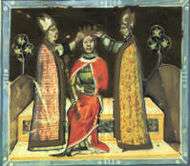 | Emeric (Emerik) | 13 April 1196 | 30 November 1204 | son of Béla III, king of Hungary 1196-1204 |
 | Ladislaus III (Ladislav III.) | 30 November 1204 | 7 May 1205 | son of Emerik, crowned and died as a child, king of Hungary |
 | Andrew I (Andrija II.) | 7 May 1205 | 21 September 1235 | brother of Emerik, in 1222 issued Golden Bull which established the rights of noblemen, including the right to disobey the King when he acted contrary to law (jus resisted), king of Hungary 1205-1235 |
 | Béla IV | 21 September 1235 | 3 May 1270 | son of Andrew II, ruled during First Mongol invasion (1241–42), in 1242 issued Golden Bull and proclaimed Zagreb and Samobor a Free Royal Borough (free and royal city), king of Hungary 1235-1270 |
 | Stephen VI (Stjepan V.) | 3 May 1270 | 6 August 1272 | son of Béla IV, prince of Slavonia 1246-1257, king of Hungary 1270-1272 |
 | Ladislaus IV the Cuman (Ladislav IV. Kumanac) | 6 August 1272 | 10 July 1290 | son of Steven V.; unsuccessful Mongol invasion; lived with the nomad Cuman tribes, king of Hungary 1272-1290 |
 | Andrew II (Andrija III. Mlečanin) | 4 August 1290 | 14 January 1301 | grandson of Andrew II, born in Venice; last of the Árpád dynasty, king of Hungary 1290-1301 |
House of Anjou
| Portrait | Ruler | Began | Ended | Remarks |
|---|---|---|---|---|
 | Charles Martel of Anjou (Karlo Martel) | 1290 | 1295 | set up by Pope Nicholas IV and the ecclesiastical party as successor of his maternal uncle, the childless Ladislaus IV. Crowned as the King of Croatia but not as King of Hungary |
| | Charles I (Karlo I. Robert) | 14 January 1301 | 16 July 1342 | son of Charles Martel, established the royal Angevin dynasty, king of Hungary 1308-1342. |
 | Louis I the Great (Ludovik I. Veliki) | 16 July 1342 | 11 September 1382 | king of Hungary 1342-1382, and Poland 1370-1382 |
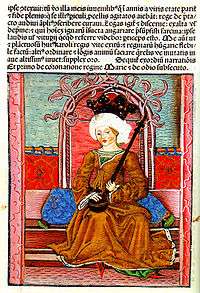 | Mary I (Marija Anžuvinska) | 11 September 1382 | 17 May 1395 | married Sigismund of Luxemburg |
 | Charles II (Karlo II. Drački) | 31 December 1385 | 24 February 1386 | also King of Naples, in opposition to Mary. Assassinated on 7 February 1386 and died on 24 February |
House of Luxembourg
| Portrait | Ruler | Began | Ended | Remarks |
|---|---|---|---|---|
 | Sigismund I (Žigmund Luksemburški) | 31 March 1387 | 9 December 1437 | later also Roman-German King (since 1410), King of Bohemia (since 1419), Holy Roman Emperor (since 1433) |
House of Anjou
| Portrait | Ruler | Began | Ended | Remarks |
|---|---|---|---|---|
.jpg) | Ladislaus of Naples (Ladislav Napuljski) | 5 August 1403 | 1409 | Son of Charles II. Claimed the Crown of Hungary and Croatia and opposed by King Sigismund of Luxemburg. Ladislas eventually sold his rights to the Venetian Republic for 100,000 ducats in 1409. |
House of Habsburg
| Portrait | Ruler | Began | Ended | Remarks |
|---|---|---|---|---|
 | Albert I | 1 January 1438 | 27 October 1439 | son-in-law of Sigismund, also Roman-German King, King of Bohemia, Duke of Austria |
Jagiellon dynasty
| Portrait | Ruler | Began | Ended | Remarks |
|---|---|---|---|---|
 | Vladislaus I (Vladislav I. Jagelović) | 15 May 1440 | 10 November 1444 | also King of Poland |
House of Habsburg
| Portrait | Ruler | Began | Ended | Remarks |
|---|---|---|---|---|
 | Ladislaus V the Posthumus (Ladislav V. Posmrtni) | 10 November 1444 | 23 November 1457 | born in 1440 after his father's death, spent most of his life in captivity. |
House of Hunyadi
| Portrait | Ruler | Began | Ended | Remarks |
|---|---|---|---|---|
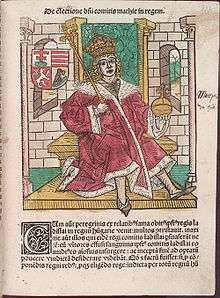 | Matthias I Corvinus (Matija Korvin) | 24 January 1458 | 6 April 1490 | son of John Hunyadi, also King of Bohemia |
Jagiellon dynasty
| Portrait | Ruler | Began | Ended | Remarks |
|---|---|---|---|---|
 | Vladislaus II (Vladislav II. Jagelović) | 15 July 1490 | 13 May 1516 | also King of Bohemia |
 | Louis II (Ludovik II.) | 13 May 1516 | 29 August 1526 | also King of Bohemia; killed in the Battle of Mohács |
House of Zápolya
Kingship disputed between Ferdinand of Austria and John Zápolya during the Ottoman invasion
| Portrait | Ruler | Began | Ended | Remarks |
|---|---|---|---|---|
 | John I (Ivan Zapolja) | 10 November 1526 | 22 July 1540 | Also claimed the throne, with support of Hungarian nobles and later Suleiman the Magnificent. |
House of Habsburg
On January 1, 1527 Croatian Parliament met in Cetin to elect Ferdinand, Archduke of Austria as the new king of Croatia.
| Portrait | Ruler | Began | Ended | Remarks |
|---|---|---|---|---|
 | Ferdinand I, Holy Roman Emperor (Ferdinand Habsburški) | 16 December 1526 | 25 July 1564 | claimed the throne according to the agreement between the House of Jagiellon and the House of Habsburg |
 | Maximilian (Maksimilijan I.) | 8 September 1563 | 12 October 1576 | ruled during Battle of Szigetvár and Croatian peasant revolt |
 | Rudolf I | 25 September 1572 | 26 June 1608 | ruled during Battle of Sisak, abdicated in favor of his younger brother Matthias |
 | Matthias II (Matija II.) | 26 June 1608 | 20 March 1619 | brother of Rudolf II |
 | Ferdinand II | 1 July 1618 | 15 February 1637 | In 1630 issued Statuta Valachorum in opposition to Croatian Parliament |
 | Ferdinand III | 8 December 1625 | 2 April 1657 | |
 | Leopold I | 27 June 1657 | 5 May 1705 | Crushed Zrinski–Frankopan Conspiracy and abolished the right of Croatian Parliament to elect king. In 1669 founded University of Zagreb |
 | Joseph I (Josip I.) | 5 May 1705 | 17 April 1711 | |
 | Charles III (Karlo III.) | 11 April 1711 | 20 October 1740 | On 9 March 1712 Croatian Parliament voted its Pragmatic Sanction in which the Kingdom of Croatia accepted female inheritance of its crown after extinction of the male line and supporting her to become Queen of Croatia |
.jpg) | Maria II Theresa (Marija Terezija) | 20 October 1740 | 29 November 1780 | Division of Croatia on županije (counties) and in 1767 forms Croatian Royal Council (Consilium Regium) until 1779 when she abolishes it. Queen conducts military and economy reforms and especially serfdom. |
House of Habsburg-Lorraine
| Portrait | Ruler | Began | Ended | Remarks |
|---|---|---|---|---|
 | Joseph II (Josip II.) | 29 November 1780 | 20 February 1790 | Abolished serfdom. Partial germanization of Croatian lands. |
.png) | Leopold II | 20 February 1790 | 1 March 1792 | |
 | Francis (Franjo I.) | 1 March 1792 | 2 March 1835 | |
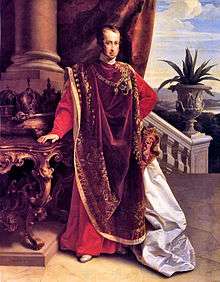 | Ferdinand V | 28 September 1830 | 2 December 1848 | Being epileptic and mentally ill, abdicated in favour of his nephew, Franz Joseph (son of his younger brother Franz Karl). Died in 1875. |
 | Francis Joseph (Franjo Josip I.) | 2 December 1848 | 21 November 1916 | Longest ruling Croatian monarch, during which reign Croatia was unified in 1848. During the reorganization of the monarchy in 1867 into a dual Austrian and Hungarian part, Croatia was divided. In 1868 the Triune kingdom of Croatia, Dalmatia and Slavonia was a autonomous kingdom in the union with Hungary. |
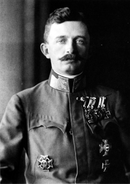 | Charles IV (Karlo IV.) | 21 November 1916 | 16 November 1918 | In his coronation oath to the Croatian parliament he acknowledged the unity of Croatia, Dalmatia and Slavonia with Rijeka.[4] During the last days of the monarchy he accepted the trialist manifest on creating the Zvonimir's kingdom.[5][6][6][7][8][9] He reigned until 1918, when he "renounced participation" in state affairs, but did not abdicate. The Croatian Sabor (parliament) ended the union of Croatia with Hungary and Austria on 29 October 1918 but never dethroned king Karl IV.[10] He spent the remaining years of his life attempting to restore the monarchy until his death in 1922. |
Kings of Yugoslavia
After the World War I and the breakup off of Austria-Hungary, Croatia joined a newly formed State of Slovenes, Croats and Serbs. Following a brief period of self-rule, that state became part of the Kingdom of Serbs, Croats, and Slovenes under the Karađorđević dynasty. The name of the kingdom was changed in 1929 amid unitarianist reforms to "King of Yugoslavia". During this period, in 1941 Croatia was occupied by the Axis powers along with the rest of Yugoslavia.
House of Karađorđević
| Portrait | Ruler | Began | Ended | Remarks |
|---|---|---|---|---|
.jpg) | Peter I | 1 December 1918 | 16 August 1921 | |
 | Alexander I | 16 August 1921 | 9 October 1934 | |
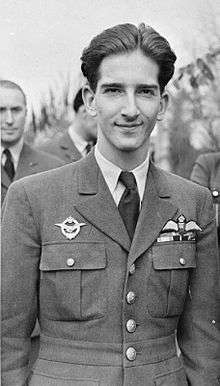 | Peter II | 9 October 1934 | 29 November 1945 |
Independent State of Croatia
House of Savoy-Aosta
During the German occupation of Yugoslavia, a puppet-state under Italian protection called the Independent State of Croatia was created with its leader Ante Pavelić. Soon after the creation of the state its government passed three laws on the creation of the crown of Zvonimir, which made the country a kingdom.[11][12] Three days later the Rome treaties were signed. Italian prince Aimone, Duke of Spoleto was designated King of Croatia. He abdicated in 1943.
| Portrait | Ruler | Began | Ended | Remarks |
|---|---|---|---|---|
 | | 18 May 1941 | 31 July 1943 | Tomislav II established a Croatian royal office (kraljevski stol) in Florence and later in Rome.[13][14] He had at first refused to assume the kingship in opposition to the Italian annexation of the Dalmatia region,[15] and is therefore referred to in some sources as king designate.[16][17][18][19] He abdicated on 31 July 1943 after the dismissal of Musolini on the orders of Victor-Emanuel III.[20][21][22][23] |
Post-monarchy
See:
- Heads of state of Yugoslavia (1945-1991)
- List of Presidents of Croatia (1991–present)
See also
- List of rulers of Hungary for a list of monarchs between 1526 and 1918—mostly accurate for the Croatian lands
- List of rulers of Austria
- Croatian Parliament
- Ban of Croatia
- History of Croatia
- Timeline of Croatian history
References
- ↑ Thomas the Archdeacon: Historia Salonitana, caput 13.
- ↑ Catholic Encyclopedia
- ↑
- ↑ (Hrvatska) Krunidbena zavjernica Karla IV. hrvatskom Saboru 28. prosinca 1916. (sa grbom Dalmacije, Hrvatske, Slavonije i Rijeke iznad teksta), str. 1.-4. Hrvatski Državni Arhiv./ENG. (Croatian) Coronation oath of Karl IV to Croatian Sabor (parliament), 28th December 1916. (with coat of arms of Dalmatia, Croatia, Slavonia and Rijeka above the text), p.1-4 Croatian State Archives
- ↑ A. Pavelić (lawyer) Doživljaji, p.432.
- 1 2 Dr. Aleksandar Horvat Povodom njegove pedesetgodišnjice rodjenja, Hrvatsko pravo, Zagreb, 17/1925., no. 5031
- ↑ Edmund von Glaise-Horstenau,Die Katastrophe. Die Zertrümmerung Österreich-Ungarns und das Werden der Nachfolgestaaten, Zürich – Leipzig – Wien 1929, p.302-303.
- ↑ Same page 132.-133.
- ↑ F. Milobar Slava dr. Aleksandru Horvatu!, Hrvatsko pravo, 20/1928., no. 5160
- ↑ Hrvatska Država, newspaper Public proclamation of the Sabor 29.10.1918. Issued 29.10.1918. no. 299. p.1.
- ↑ Hrvatski Narod (newspaper)16.05.1941. no. 93. p.1.,Public proclamation of theZakonska odredba o kruni Zvonimirovoj (Decrees on the crown of Zvonimir), tri članka donesena 15.05.1941.
- ↑ Die Krone Zvonimirs, Monatshefte fur Auswartige Politik, Heft 6(1941)p.434.
- ↑ Hrvoje Matković, Designirani hrvatski kralj Tomislav II. vojvoda od Spoleta. Povijest hrvatskotalijanskih odnosa u prvoj polovici XX.st. (Designated Croatian king Tomislav II. Duke of Spoleto. History of Croatian-Italian relationships in first half of the 20th century), Zagreb 2007.
- ↑ Avramov, Smilja (1995). Genocide in Yugoslavia. p. 238.
- ↑ Rodogno, Davide; Fascism's European empire: Italian occupation during the Second World War; p.95; Cambridge University Press, 2006 ISBN 0-521-84515-7
"Devoid of political experience and ignorant of the Italian government's exact intentions, he [the Duke Aimone] refused to leave for Croatia, saying so in letters to Victor Emmanuel and Mussolini, in which he told them that the question of Dalmatia, 'a land that could never be Italianized', was an obstacle against any reconciliation with the Croats. Never, he declared, would he agree to be a king of a nation amputated from Italy." . - ↑ Pavlowitch, Stevan K.; Hitler's new disorder: the Second World War in Yugoslavia; p.289; Columbia University Press, 2008 0-231-70050-4
- ↑ Massock, Richard G.; Italy from Within; p.306; READ BOOKS, 2007 ISBN 1-4067-2097-6
- ↑ Burgwyn, H. James; Empire on the Adriatic: Mussolini's conquest of Yugoslavia 1941-1943; p.39; Enigma, 2005 ISBN 1-929631-35-9
- ↑ Royal Institute of International Affairs; Enemy Countries, Axis-Controlled Europe; Kraus International Publications, 1945 ISBN 3-601-00016-4
- ↑ "Duke gives up puppet throne". St. Petersburg Times. 21 August 1943. p. 10.
- ↑ Lemkin, Raphael; Power, Samantha (2005). Axis Rule In Occupied Europe: Laws Of Occupation, Analysis Of Government, Proposals For Redress. Lawbook Exchange. p. 253. ISBN 1584775769.
- ↑ "Foreign News: Hotel Balkania". Time Magazine. 9 August 1943. Retrieved 4 December 2009.
- ↑ B. Krizman, NDH između Hitlera i Mussolinija (Independent State of Croatia between Hitler and Mussolini,)p.102
External links
- Monarchs of Croatia from Everything2
- The History Files: Kingdoms of Eastern Europe: Croatia
- WHKMLA History of Croatia, ToC
- Rulers of Croatia and Slavonia
- List of Croatian rulers PDF, University of Michigan
- List of Croatian Heads of State